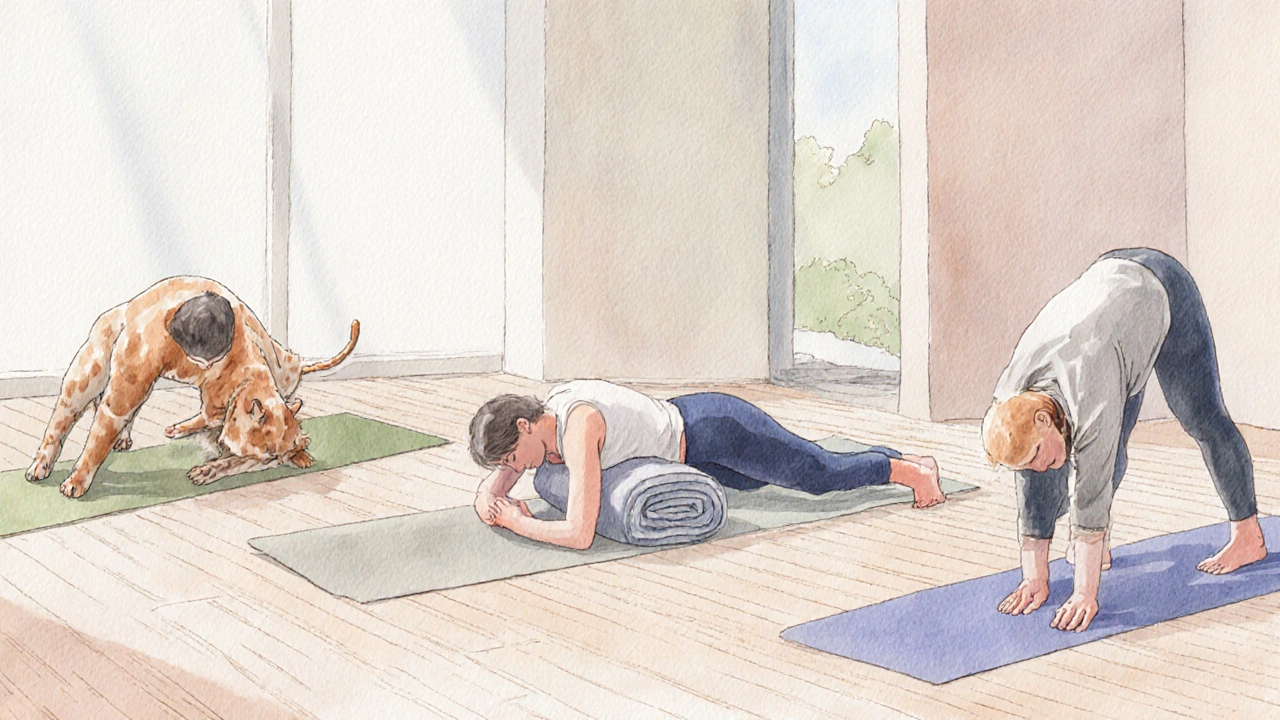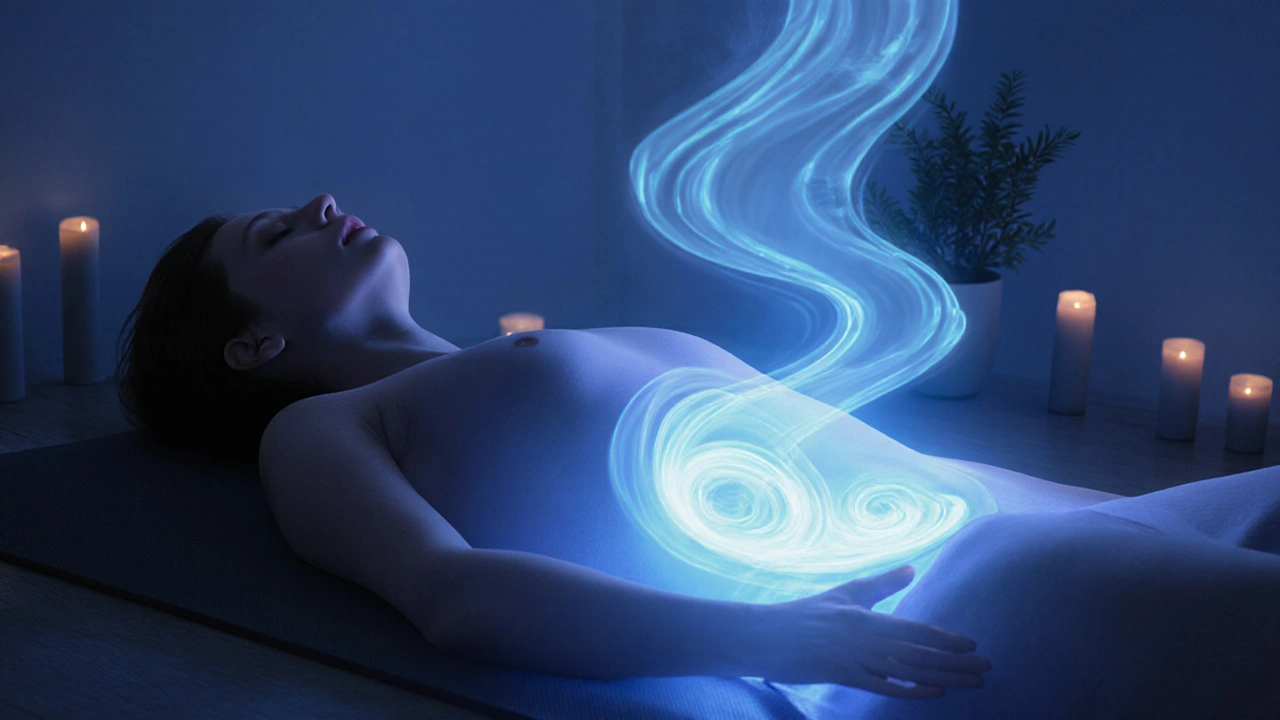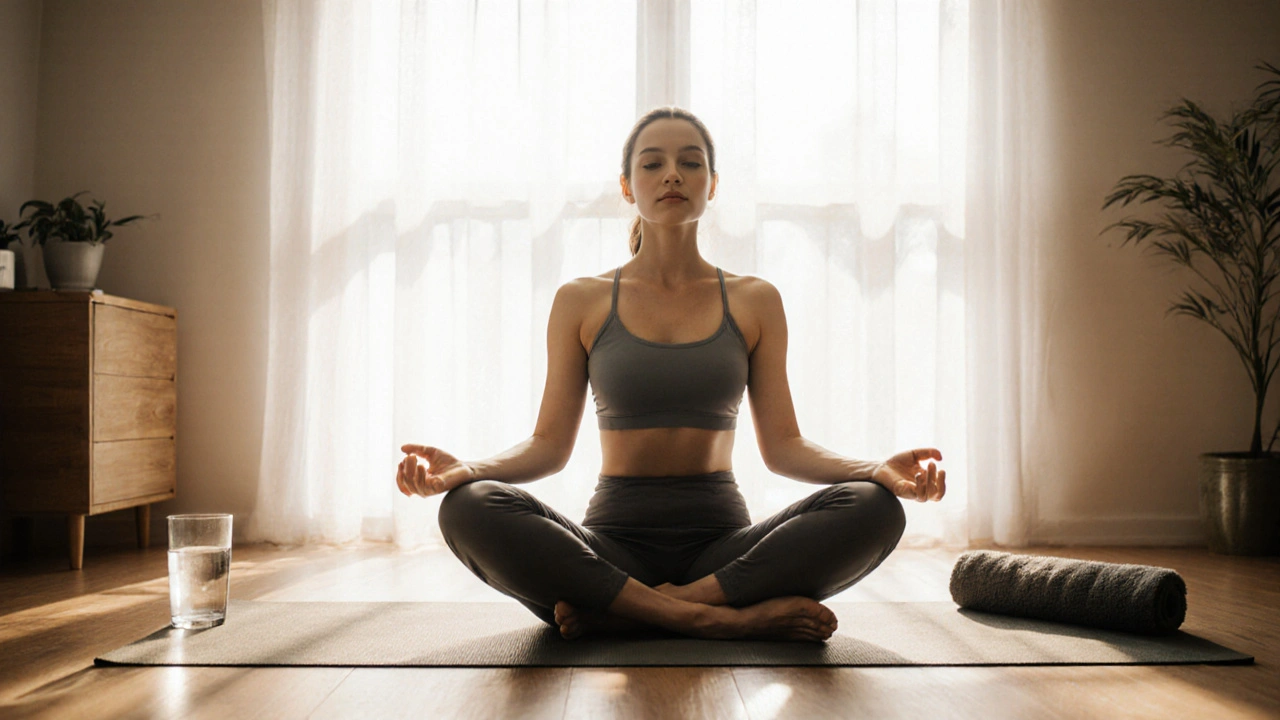Yoga for Cystitis Relief: 15-Minute Routine Timer
Pose 1: Cat-Cow
1 minute
Massages the organs, improves circulation
Pose 2: Reclining Bound Angle
1-2 minutes
Gentle stretch of the pelvic floor, promotes relaxation
Pose 3: Wind-Release Pose
1 minute
Helps release trapped gas, eases pressure on the bladder
Pose 4: Child's Pose
1 minute
Calms the nervous system, reduces stress-induced inflammation
- Hold each pose for the recommended time.
- Breathe evenly through the nose.
- Stop if you feel sharp pain.
- Stay hydrated and empty your bladder before starting.
When it comes to managing Cystitis-a painful bladder inflammation-many turn to Yoga for gentle, drug‑free relief.
Key Takeaways
- Yoga can lower stress, improve pelvic floor tone, and boost circulation, all of which may lessen cystitis discomfort.
- Specific poses-such as Supta BaddhaKonasana, Cat‑Cow, and Pawanmuktasana-target the lower abdomen and pelvic region.
- A short, 15‑minute routine done 3‑4 times a week can complement medical treatment without replacing it.
- Hydration, proper breathing, and listening to your body are essential safety tips.
- Consult a healthcare professional before starting any new exercise program, especially during an active infection.
Understanding Cystitis and Its Triggers
Urinary tract infection (UTI) is the umbrella term that includes cystitis, which specifically affects the bladder lining. Common symptoms are burning during urination, urgency, lower‑abdominal cramping, and sometimes mild fever. While antibiotics are the frontline treatment, recurrent cases often have lifestyle contributors such as stress, dehydration, and weak pelvic floor muscles.
Stress triggers the release of cortisol, a hormone that can dampen the immune system. A weakened immune response makes it easier for bacteria to colonise the bladder, prolonging inflammation. Likewise, chronic tension in the pelvic area can restrict blood flow and impede the natural flushing action of urine.
Why Yoga Might Help
Yoga combines three core elements that directly address cystitis triggers: mindful breathing, gentle movement, and relaxation.
- Stress reduction: Controlled breathing (pranayama) activates the parasympathetic nervous system, lowering cortisol levels and supporting immune health.
- Pelvic floor activation: Certain poses engage and lengthen the pelvic floor muscles, helping them contract and release more efficiently.
- Improved circulation: Forward bends and hip‑openers increase blood flow to the lower abdomen, encouraging the bladder to clear irritants faster.
Because the practice is low‑impact, it’s safe for most adults, even those who are currently experiencing mild symptoms. The key is to avoid any pose that creates pressure on a full bladder or forces the abdomen to contract sharply.

Essential Yoga Poses for Cystitis Relief
Below is a concise routine. Hold each pose for 30‑45 seconds, breathing evenly through the nose. Move slowly and stop if you feel any sharp pain.
| Pose | Target Area | Main Benefit |
|---|---|---|
| Supta BaddhaKonasana (Reclining Bound Angle) | Lower abdomen, inner thighs | Gentle stretch of the pelvic floor, promotes relaxation |
| Marjariasana‑Bitilasana (Cat‑Cow) | Spine, abdominal muscles | Massages the organs, improves circulation |
| Pawanmuktasana (Wind‑Release Pose) | Digestive tract, bladder | Helps release trapped gas, eases pressure on the bladder |
| Balasana (Child’s Pose) | Back, hips | Calms the nervous system, reduces stress‑induced inflammation |
| Mula Bandha Activation (Root Lock) | Pelvic floor | Strengthens the floor muscles without strain |
Step‑by‑Step 15‑Minute Routine
- Begin seated, take 5 deep Ujjayi breaths to settle the mind.
- Transition into Cat‑Cow for 1 minute, syncing breath with movement.
- Ease into Supta BaddhaKonasana. Place a folded blanket under the knees for support. Stay for 1‑2 minutes, focusing on diaphragmatic breathing.
- Roll onto your back and perform Pawanmuktasana. Gently hug the knees to the chest, then release. Repeat 4‑5 times.
- Shift to Balasana. Spread the knees wide, extend the arms forward, and breathe for 1 minute.
- Finish with a seated MulaBandha activation: lightly contract the perineum (as if stopping the flow of urine) for 5 breaths, then release.
- Close the session with a 2‑minute savasana (lying still), visualising the bladder draining cleanly.
This routine targets the bladder, reduces stress, and gently tones the pelvic floor-three factors that can make cystitis symptoms feel less intense.
Safety Tips and Common Pitfalls
- Never practice on a full bladder. Empty before starting to avoid unnecessary pressure.
- Stay hydrated throughout the day; water helps flush bacteria out of the urinary tract.
- Avoid deep twists or inversions while symptoms are severe, as they can increase intra‑abdominal pressure.
- If a pose causes burning or sharp pain, back off or modify. Pain is a signal that the body needs a gentler approach.
- Combine yoga with other lifestyle measures-regular bathroom breaks, breathable cotton underwear, and a balanced diet low in irritants like caffeine.

When to Seek Professional Help
Yoga is a complementary strategy, not a cure. If you notice any of the following, contact a healthcare provider immediately:
- Fever above 100.4°F (38°C) or chills.
- Blood in the urine.
- Pain that worsens despite antibiotics.
- Recurring infections (more than three episodes in a year).
In those cases, a doctor may need to adjust medication or investigate underlying conditions such as kidney stones or bladder anomalies.
Putting It All Together: A Sample Week Plan
| Day | Routine | Notes |
|---|---|---|
| Monday | 15‑minute routine | Focus on breathing, keep water intake high |
| Tuesday | Gentle walk + hydration | Rest day for yoga, maintain bladder health |
| Wednesday | 15‑minute routine | Add a 5‑minute meditation after savasana |
| Thursday | Rest or light stretching | Listen to your body |
| Friday | 15‑minute routine | Increase hold time to 60 seconds per pose if comfortable |
| Saturday | Gentle yoga flow (30min) focusing on hips | Optional extra session |
| Sunday | Rest + review symptoms | Note any changes, adjust routine as needed |
Frequently Asked Questions
Can yoga replace antibiotics for cystitis?
No. Yoga supports recovery and may reduce symptom severity, but antibiotics treat the underlying bacterial infection. Always follow your doctor’s prescription.
How soon can I feel relief after starting the routine?
Many people notice reduced pelvic tension and calmer bladder urges within a few days, especially if stress was a major trigger. Full symptom improvement varies from one to two weeks.
Are there any poses to avoid during an active infection?
Avoid deep forward folds that compress the abdomen, inversions like Headstand, and intense core work such as Boat Pose. These can increase pressure on the bladder and cause discomfort.
Can men use yoga for cystitis symptoms?
Yes. Although cystitis is more common in women, men can experience bladder inflammation. The same poses that open the hips and relax the pelvic floor are beneficial for both genders.
How does breath work influence bladder health?
Slow diaphragmatic breathing stimulates the vagus nerve, which lowers stress hormones. Reduced stress lessens inflammation, allowing the bladder lining to heal faster.
In short, integrating yoga for cystitis into your weekly routine can be a soothing, supportive layer alongside medical care. With the right poses, mindful breathing, and a few lifestyle tweaks, you’ll likely find the burning and urgency become more manageable.

William Pitt
October 9, 2025 AT 23:45Hey folks, I've been experimenting with the cystitis yoga routine and it really helped calm the burning feeling I get during flare‑ups. The breathing focus in Cat‑Cow seems to massage the lower abdomen and ease tension. I try to do the flow three times a week, always emptying my bladder first so there's no extra pressure. Remember to keep the movements gentle; the goal is relaxation, not strain. If you stay consistent you'll notice the urgency dropping and the overall discomfort lessening.
Jeff Hershberger
October 14, 2025 AT 23:45Honestly, the whole "wind‑release pose" sounds like a poopy metaphor, but it actually works better than you think.
Jesse Najarro
October 19, 2025 AT 23:45I tried the child’s pose after a long day and felt the stress melt away. The pelvic floor really does loosen up with the reclined bound angle. It’s a simple sequence that anyone can fit into a coffee break. Just remember to stay hydrated and avoid a full bladder.
Dan Dawson
October 24, 2025 AT 23:45Cool tip, I like the short routine.
Lawrence Jones II
October 29, 2025 AT 23:45The protocol leverages diaphragmatic ventilation to activate the vagal tone 🧘♀️, which modulates the hypothalamic‑pituitary‑adrenal axis and reduces cortisol output. By lowering systemic inflammation you give the urothelium a chance to repair. Plus the hip‑opening biomechanics improve perfusion to the trigone region. Keep the flow fluid and avoid high‑intensity core work during an active infection 🚫.
Robert Frith
November 3, 2025 AT 23:45Listen up lads, if you’re not emptyin' that bladder before you start, you’re practically askin' for pain. The whole idea of "gentle yoga" gets trashed when you go in with a full sack. So take a tinkle, then roll into that cat‑cow and feel the relief. Trust me, I’ve learned the hard way, and my back was thankin' me.
Albert Gesierich
November 8, 2025 AT 23:45Just a quick note: the article says “stay hydrated and empty your bladder before starting.” It should be “stay hydrated and empty your bladder before you start,” because “starting” refers to the routine, not the hydration.
Brad Tollefson
November 13, 2025 AT 23:45The timer code snippet seems fine, but you might want to reset totalSeconds to 15*60 + 1 so the display doesn’t jump straight to 00:00 on first load. Also, remember to disable the pause button until the timer actually runs – otherwise users can click it uselessly.
Paul van de Runstraat
November 18, 2025 AT 23:45Wow, thanks for the nit‑picking, now I feel totally motivated to double‑check my yoga script. Maybe next we’ll get a peer‑review on how to do the perfect savasana without falling asleep.
Suraj Midya
November 23, 2025 AT 23:45Honestly I think some of this yoga stuff is just a fad from abroad, we should stick to good old home‑grown remedies and not waste time on fancy poses.